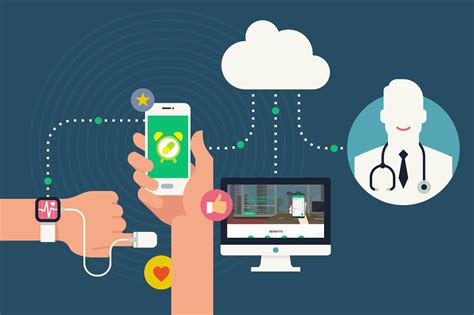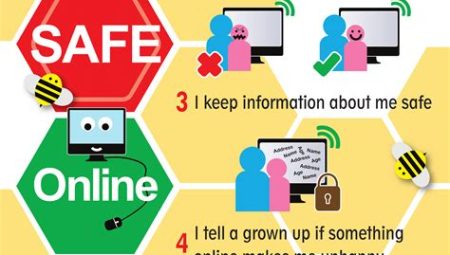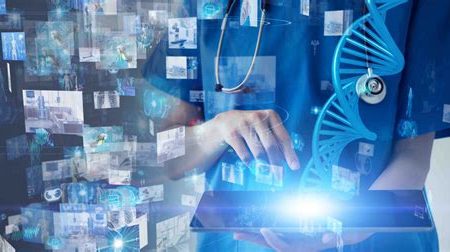Health Technologies: Paving the Way for a Healthier and More Connected World
In today’s rapidly evolving world, technological advancements have significantly impacted various aspects of our lives, including healthcare. From wearable devices to big data analytics, the integration of technology in the healthcare industry has revolutionized the way we approach personal health monitoring, diagnosis, treatment, and overall patient experience. In this blog post, we will explore the various ways in which health technologies are not only shaping the future of healthcare but also paving the way for a healthier and more connected world. We will delve into the transformative effects of wearable devices, telemedicine, artificial intelligence, virtual reality, the internet of things, robotics in surgery, mobile health apps, big data analytics, genomics and personalized medicine, and blockchain in healthcare. Join us as we navigate through the exciting innovations that are redefining the healthcare landscape and empowering individuals to take control of their health.
Table of Contents
Wearable Devices: Revolutionizing Personal Health Monitoring
Wearable devices have taken personal health monitoring to a whole new level, allowing individuals to track their fitness and health in real-time. These devices, such as fitness trackers and smartwatches, have become an integral part of many people’s daily lives, providing valuable data on their physical activity, sleep patterns, and heart rate.
With the help of wearable devices, individuals can take proactive steps towards improving their health and well-being. They can set goals, monitor their progress, and make informed decisions about their lifestyle choices. The convenience and accessibility of these devices have made it easier for people to stay on top of their health without having to rely solely on healthcare professionals.
Furthermore, the data collected by wearable devices can be shared with healthcare providers, enabling them to have a more comprehensive view of their patients’ health. This real-time data can lead to more accurate diagnoses, personalized treatment plans, and improved patient outcomes.
In conclusion, the integration of wearable devices into personal health monitoring has revolutionized the way individuals manage their health. With the ability to track and analyze various health metrics, people are empowered to take control of their well-being and work towards a healthier lifestyle.
Telemedicine: Bridging the Gap Between Patients and Healthcare Providers
Telemedicine, also known as telehealth, is a revolutionary approach to healthcare delivery that utilizes technology to connect patients with their healthcare providers. This innovative method of medical care has become increasingly popular in recent years, especially with the advancement of digital communication and remote monitoring tools.
One of the key advantages of telemedicine is its ability to bridge the gap between patients and healthcare providers, particularly in rural or underserved areas where access to healthcare services may be limited. By leveraging video conferencing, mobile apps, and other digital platforms, patients can easily connect with their doctors and receive timely medical advice and consultations.
Furthermore, telemedicine has the potential to improve patient outcomes by facilitating early diagnosis, providing continuous monitoring, and promoting better patient engagement. In addition, it offers convenience and flexibility, allowing patients to access medical care from the comfort of their own homes, reducing the need for unnecessary travel and minimizing wait times.
By embracing telemedicine, healthcare providers can expand their reach, improve access to care, and enhance patient satisfaction. This technology-driven approach not only benefits individual patients but also contributes to the overall efficiency and effectiveness of the healthcare system.
Artificial Intelligence in Healthcare: Enhancing Diagnosis and Treatment
Artificial Intelligence (AI) is rapidly transforming the healthcare industry, particularly in the areas of diagnosis and treatment. With the ability to analyze complex medical data at an unprecedented speed and accuracy, AI is revolutionizing the way healthcare professionals identify and address various diseases and conditions.
By leveraging AI-powered algorithms and machine learning, healthcare providers can access crucial insights that may have previously been overlooked. This allows for earlier detection and intervention, ultimately leading to improved patient outcomes and quality of care.
Furthermore, AI is enhancing the precision and personalization of treatment plans. Through the analysis of patient data and medical records, AI can help identify the most effective treatment options based on individual characteristics, leading to more tailored and effective care.
Ultimately, the integration of AI in healthcare is not only enhancing diagnosis and treatment but also revolutionizing the entire patient experience, paving the way for more efficient and effective healthcare delivery.
Virtual Reality in Rehabilitation: Transforming the Healing Experience
Virtual Reality (VR) technology is revolutionizing the field of rehabilitation, providing patients with a unique and transformative healing experience. By immersing patients in a simulated environment, VR therapy allows individuals to engage in activities and experiences that may not be possible in the real world. This immersive experience has been shown to have a positive impact on physical and cognitive rehabilitation, helping patients regain lost skills and improve their overall quality of life.
One of the key benefits of VR in rehabilitation is its ability to create a safe and controlled environment for patients to practice essential movements and tasks. For individuals recovering from injuries or undergoing physical therapy, VR simulations can provide a low-risk setting to build strength, improve balance, and increase mobility. This technology also has the potential to reduce the fear and anxiety often associated with rehabilitation, making the process more enjoyable and motivating for patients.
Furthermore, VR therapy can be tailored to the specific needs and abilities of each patient, allowing for personalized treatment plans and interventions. Whether it’s through interactive games, guided exercises, or simulated real-life scenarios, VR technology offers a flexible and customizable approach to rehabilitation. This individualized approach can lead to better outcomes and faster recovery times for patients undergoing rehabilitation.
In addition to its physical benefits, VR in rehabilitation also has the potential to improve the mental and emotional well-being of patients. By transporting individuals to virtual environments that are calming, stimulating, or nostalgic, VR therapy can help alleviate stress, depression, and loneliness during the rehabilitation process. This holistic approach to healing can enhance the overall experience for patients and contribute to their overall well-being.
Internet of Things: Enabling Smart Healthcare Systems
The Internet of Things (IoT) is revolutionizing the way healthcare systems operate and deliver services. With the integration of IoT devices and sensors, hospitals and healthcare facilities are now able to collect real-time data to monitor patients and assets, streamline operations, and improve overall patient care.
Through smart devices such as wearable health monitors, smart beds, and connected medical equipment, healthcare providers can access critical patient information remotely, enabling them to make timely and informed decisions that can significantly impact patient outcomes.
Furthermore, IoT enables the automation of routine tasks, such as inventory management, medication tracking, and environmental monitoring, allowing healthcare professionals to focus on delivering personalized care and improving operational efficiency.
The implementation of IoT in healthcare not only enhances patient care but also contributes to cost reduction, resource optimization, and improved overall healthcare delivery.
Robotics in Surgery: Advancing Precision and Efficiency
Robotic surgery, also known as robot-assisted surgery, is a surgical approach that utilizes robots to perform complex procedures with high precision. This technology has revolutionized the field of surgery by providing greater accuracy and efficiency compared to traditional methods.
One of the key benefits robotics in surgery is its ability to minimize the invasiveness of procedures, resulting in smaller incisions, less pain, and faster recovery times for patients. The robots are controlled by skilled surgeons, who can manipulate the robotic arms with precision and dexterity that surpasses human capability.
Furthermore, robotics in surgery allows for enhanced visualization, as the robotic system provides surgeons with a magnified, high-definition, 3D view of the surgical site. This level of detail enables surgeons to perform intricate maneuvers with greater accuracy, ultimately improving patient outcomes.
In addition, robotics in surgery has the potential to reduce the risk of complications, as the technology enables surgeons to avoid surrounding tissues and organs that are not involved in the procedure. This level of precision minimizes the likelihood of damage to healthy structures, leading to improved overall patient safety and reduced post-operative complications.
Mobile Health Apps: Empowering Individuals to Manage Their Health
In today’s digital age, mobile health apps have become essential tools for individuals looking to take charge of their own well-being. These apps allow users to easily track their fitness goals, monitor their medical conditions, and access valuable health resources right at their fingertips.
With the rise of mobile health apps, individuals are empowered to become active participants in their own healthcare management. These apps provide a convenient way for users to monitor their physical activity, manage their medications, and even consult with health professionals through telemedicine services.
By offering personalized health recommendations and reminders, these apps help individuals stay on track with their health goals. Whether it’s tracking their caloric intake, monitoring their blood sugar levels, or scheduling doctor appointments, mobile health apps make it easier for individuals to stay proactive about their healthcare.
Furthermore, mobile health apps have the potential to reach individuals who may not have easy access to traditional healthcare services. Whether it’s due to geographical barriers or time constraints, these apps bridge the gap by providing valuable health information and support to a wider audience.
Big Data Analytics: Revolutionizing Healthcare Research and Development
Big Data Analytics is transforming the way healthcare research and development is conducted, allowing for more efficient and effective processes. By leveraging large datasets, healthcare organizations are able to analyze trends, insights, and patterns that can lead to groundbreaking discoveries and innovative solutions.
This technology is revolutionizing the healthcare industry by enabling researchers to make data-driven decisions, identify potential risks, and develop personalized treatment plans. With the help of Big Data Analytics, medical professionals can also predict disease outbreaks, optimize operational workflows, and improve patient outcomes.
Furthermore, the integration of Big Data Analytics in healthcare research and development has the potential to accelerate the drug discovery process, reduce costs, and enhance the overall quality of care. By harnessing the power of advanced analytics, researchers can uncover hidden correlations and unlock valuable insights that may have previously gone unnoticed.
In conclusion, Big Data Analytics is playing a pivotal role in revolutionizing healthcare research and development. This powerful technology has the potential to drive significant advancements in the field of medicine, leading to improved patient care, enhanced efficiency, and groundbreaking innovations.
Genomics and Personalized Medicine: Tailoring Treatments to Individuals
In the field of genomics, revolutionary advances in technology have paved the way for personalized medicine, a cutting-edge approach that tailors medical treatments to the unique genetic makeup of individual patients. This breakthrough in healthcare holds tremendous promise for improving patient outcomes and revolutionizing the way we approach treatment.
By analyzing an individual’s genetic information, healthcare providers can gain invaluable insights into their predisposition to certain diseases, as well as their potential response to various medications. This personalized approach allows for more precise and effective treatment plans, ultimately leading to better patient outcomes and reduced risk of adverse reactions.
Furthermore, genomics and personalized medicine have the potential to shift healthcare from a reactive model to a proactive one, by enabling the identification of genetic risk factors and the development of targeted preventive measures. This proactive approach has the power to significantly reduce the burden of chronic diseases and improve overall population health.
As the field of genomics continues to advance, the integration of personalized medicine into mainstream healthcare is poised to transform the way we diagnose, treat, and prevent diseases. With the potential to tailor treatments to the unique genetic profiles of individuals, personalized medicine represents a significant step forward in the quest for precision and personalized healthcare.
Blockchain in Healthcare: Ensuring Privacy and Security of Medical Records
Blockchain technology is rapidly transforming the healthcare industry by providing a secure and efficient way to manage medical records. With the increasing digitization of healthcare data, the need for a secure and private system to store and share patient information has become increasingly important. Blockchain offers a decentralized and tamper-proof solution to these challenges, ensuring the privacy and security of medical records.
By utilizing blockchain technology, healthcare providers can create a transparent and immutable ledger of patient data. This not only reduces the risk of data breaches but also empowers patients to have greater control over who can access their medical records. The use of blockchain in healthcare ensures that sensitive information is only accessible to authorized individuals, preventing unauthorized access and tampering of medical records.
Moreover, blockchain technology enhances the interoperability of medical records across different healthcare systems. This enables seamless and secure sharing of patient information between healthcare providers, leading to improved care coordination and better healthcare outcomes. By leveraging the decentralized nature of blockchain, healthcare organizations can streamline data exchange while maintaining the integrity and confidentiality of patient data.
In conclusion, blockchain technology is revolutionizing the way medical records are stored and accessed in the healthcare industry. Its decentralized and secure nature ensures the privacy and security of patient information, while also promoting interoperability and transparency. As the adoption of blockchain in healthcare continues to grow, patients and healthcare providers can have confidence in the integrity and confidentiality of medical records.






